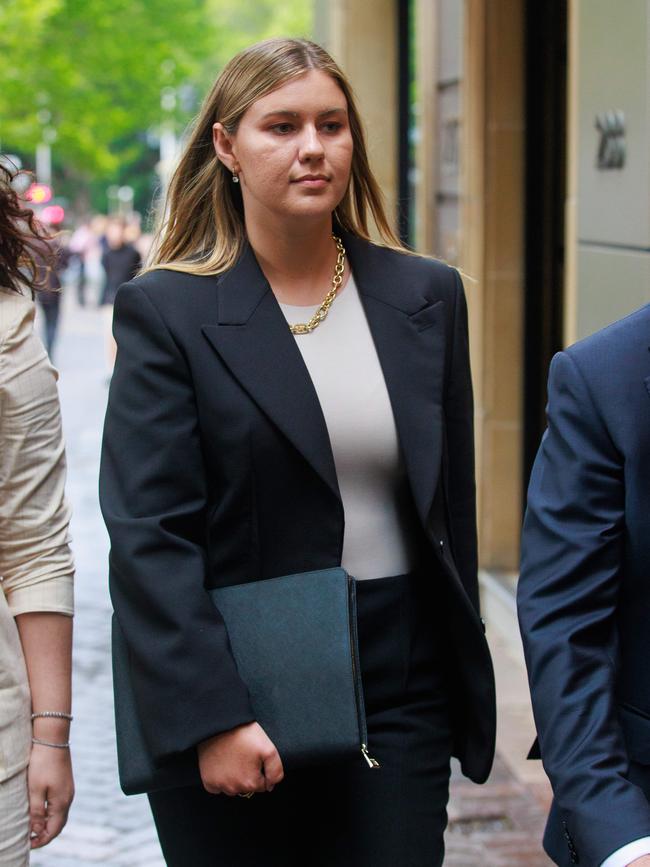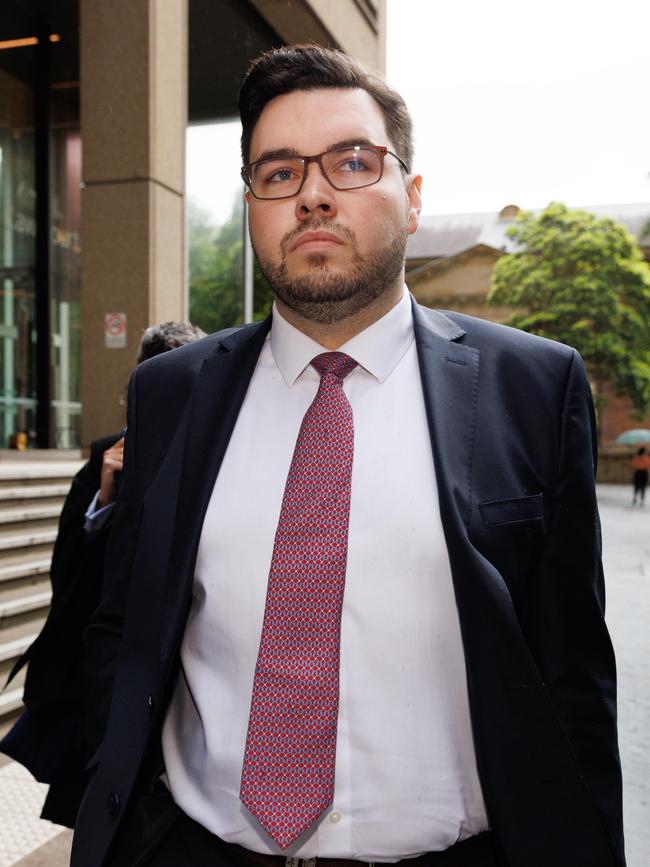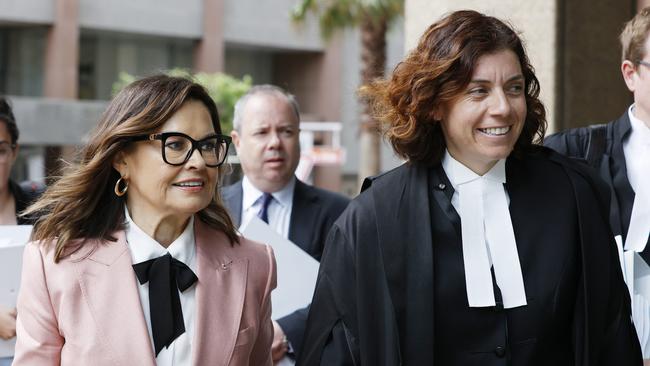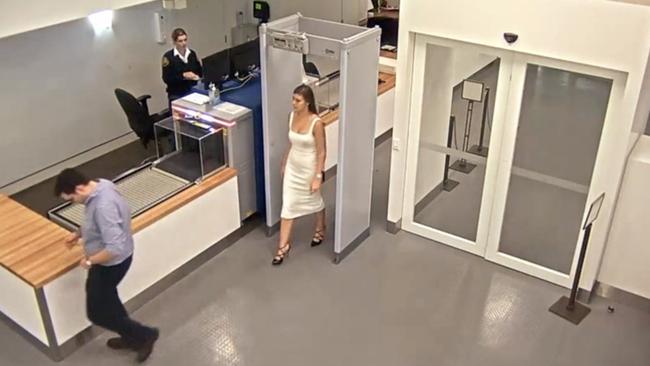Sue Chrysanthou SC: this silk doesn’t need your sympathy
Few lawyers attract praise, let alone literary prose, from the public. The formidable Sue Chrysanthou SC is different.

The first half of this live-streamed YouTube litigation has become the unofficial rape trial to determine whether the former Liberal staffer raped Brittany Higgins in Linda Reynolds’ ministerial office on March 23, 2019.
Once Ten’s lawyers decided to run a truth defence to the defamation claim, this latest chapter in the Higgins-Lehrmann saga was destined to become a gladiatorial civil sequel to last year’s criminal proceedings that ended in a mistrial after juror misconduct.
The first part of the trial dealing with the truth defence during the past fortnight will appeal to those interested in the salacious allegations surrounding the events of March 2019.
For the first time, Lehrmann is giving evidence and, more to the point, being cross-examined.
Higgins is also back in the witness box, once again giving evidence and being cross-examined, but this time she is not a complainant. This is not a criminal trial and the rules as to what evidence and what questions can be put to Higgins are markedly different.

The second half of the trial will traverse Ten and Wilkinson’s other defence: that of qualified privilege under section 30 of the Defamation Act. The defendants claim that in publishing material that was defamatory they, as a media organisation and a journalist respectively, behaved professionally, reasonably and in the public interest when airing the rape allegation against Lehrmann.
But this week, it has been all about establishing that the imputation that Lehrmann raped Higgins in Parliament House in 2019 is substantially true. Running a truth defence under section 25 of the Defamation Act can be the equivalent of knowingly buying a ticket on a runaway, driverless train. While Ten, Wilkinson and their lawyers know what evidence they have to run their qualified privilege defence, they could not know for sure what Higgins would say this week in the heat of cross-examination.
This is high-stakes litigation for all parties. A better description is a god-awful mess. The truth defence is not for the faint-hearted or the penniless. It will require enormous financial resources (in this case 40 witnesses are slated to appear), a more qualified legal team than the original prosecutors, and an understanding that, even then, the defendants are spinning a legal roulette wheel. Ten and Wilkinson must show that the imputation – conceded by them – that Lehrmann is a rapist is substantially true. The standard of proof is the balance of probabilities, but the court must take into account the gravity of the matters alleged in forming a view as to whether the standard is met.

This means that an allegation of a serious crime requires more evidence to satisfy the standard of proof than a lesser crime. Lehrmann and others potentially defamed for allegedly committing serious crimes have one of Australia’s greatest judges – Sir Owen Dixon – to thank for this bit of common sense. His obiter comments in Briginshaw v Briginshaw from 1938 ultimately were codified into section 140 (2) of the Evidence Act.
Matt Collins KC – whose chosen salutation is Dr – elicited many concessions from Lehrmann during a cross-examination that ended this week. Lehrmann admitted to buying Higgins alcoholic drinks on the night she was allegedly raped, despite earlier saying he couldn’t recall. He admitted to lying about why he went to Parliament House that same evening. Justice Michael Lee heard that, after news first broke publicly of the alleged rape, Lehrmann sent a message to a close friend saying: “They wouldn’t name, would they?” Collins put to Lehrmann that this message “reveals a consciousness that you knew the allegations were about you”. Lehrmann denied this.
Lehrmann faced more forensic interrogation from the formidable Sue Chrysanthou SC on Tuesday.

When Wilkinson parted with Ten’s legal team, she chose the barrister who was once metaphorically serenaded by a stranger writing on the letters page of a newspaper.
After Chrysanthou interrogated Shane Drumgold at the Sofronoff inquiry, this letter writer quoted Sir Walter Scott’s The Lady of the Lake: “With head upraised, and look intent,/And eye and ear attentive bent,/ And locks flung back, and lips apart,/ Like monument of Grecian art.” Few lawyers attract praise, let alone literary prose, from the public.
The thrust of Chrysanthou’s cross-examination of Lehrmann was to elicit from him that he believed it was Drumgold who ruined his life. While Sofronoff found that Drumgold “deliberately advanced a false claim of legal professional privilege and misled the court” to keep relevant documents from the defence”, Chrysanthou’s real aim was to remind the judge that Sofronoff found that the ACT chief prosecutor also “knowingly lied” to the ACT Chief Justice when claiming that a note about the warning he allegedly gave Wilkinson before her Logies speech was written “contemporaneously” by his instructing solicitor.
Where Chrysanthou goes, there is usually colour and movement. Her live-streamed tete-a-tete this week with Lee, who not unreasonably wanted to prevent any double-barrelled cross-examination of Lehrmann, was misconstrued by some dolts on X as a wicked male judge treating a poor female silk with disdain. Pfff. Chrysanthou gives as good as she gets, which is one reason she is a sought-after silk. The other reason is that she wins defamation cases, not just using qualified privilege but on the harder truth defence.

In August, Chrysanthou scored a legal victory for Pauline Hanson, overturning on appeal a $250,000 defamation bill Hanson copped for making claims that Brian Burston sexually abused a female staff member in his parliamentary office. The appeal court found that Burston had engaged in “degrading and humiliating” conduct towards his staffer. In that case there was corroborating evidence to support Hanson’s truth defence.
In court 22A during the past fortnight, Justice Lee has far less to work with – there are only two diametrically opposite accounts of he said-she said.
When Higgins arrived late on Tuesday afternoon to give evidence, many were reminded of a tweet she posted on December 7 last year, just six days after then ACT director of public prosecutions Drumgold announced he would not pursue a second trial of Lehrmann because of her mental health. Higgins tweeted that she was “willing to defend the truth as a witness in any potential civil cases brought by Mr Lehrmann”, adding later that it would be “in a slightly more favourable court”.
What did Higgins mean by more favourable? During the criminal trial, neither the DPP nor ACT Chief Justice Lucy McCallum was unfavourable to her. Perhaps Higgins imagined that Lehrmann’s criminal barrister, Steve Whybrow SC, would not be part of a possible civil case. If so, she was wrong: Whybrow cross-examined her again his week. And this time Higgins has faced questions that McCallum would not allow during the rape trial because in this civil proceeding the former Liberal staff member is no longer a complainant. Perhaps by more favourable, Higgins meant in a defamation trial a different standard of proof applies. That is certainly the case. But still, the likelihood of this trial establishing the truth is a 50-50 bet at best.
On Thursday, just before 11am, Whybrow’s cross-examination of Higgins began. Higgins admitted lying to police and her friend Ben Dillaway about going to the doctor for STD checks. She admitted to lying about wearing underwear on the night of the alleged incident in her early discussion with Wilkinson. Most damaging, she admitted the bruise on her leg that she photographed might have been caused by her “tripping up the stairs” while drunk that night. Under oath at the criminal trial she said the bruise was sustained “during the course of the assault”. She made the same claim to Wilkinson to corroborate the allegation that kicked off a national scandal.
Whybrow put to Higgins that she tried to save her job by claiming she was raped in the minister’s office. Higgins rejected that. Whybrow’s contention is that Higgins had a pattern of adjusting her version of events when new material came to light, and that she had financial incentives from her book deal to maintain the lie that Lehrmann raped her.

In a moment of high drama, or maybe high farce, Higgins told Justice Lee: “If I ever actually finish the book, I will donate all $200,000 whatever to charity. I don’t care about the money.”
The trial has exposed inconsistent statements and lies by both Lehrmann and Higgins. Who knows how many more lies there are? While on social media the Higgins and Lehrmann camps have bunkered down, lobbing vile abuse at their chosen nemesis, including the lawyers, Justice Lee will have to determine who, on the balance of probabilities, is lying.
So far, the legal fraternity is divided. Some say Lehrmann’s admissions have destroyed his chance of negating Ten’s truth defence. Others say the opposite, that there is no smoking gun and judges see inconsistencies and lies elicited in the witness box all the time without it being fatal to a defamation claim.
The second part of the trial, presumably starting next week, will be the main attraction for those more interested in the role of the media. Ten and Wilkinson are relying on qualified privilege in airing the allegation in the way they did some two years after the relevant events. We will learn whether they acted professionally, checking sources, distinguishing between allegations, suspicions and proven facts, and whether it was in the public interest for them to air The Project interview. More on that here next week.
However, the main issue for thoughtful Australians won’t be on trial in the Federal Court. The question we must all wrestle with is how serious #MeToo allegations should be dealt with.
Should allegations be ventilated in public, and litigated in large part by the media and political classes before they get to a court? If so, how does one preserve the presumption of innocence, due process and an uncontaminated jury pool?
#MeToo advocates may have been delighted at the momentum started by The Project interview with Higgins, and unconcerned about any damage to Lehrmann. Critics, on the other hand, worry that the ends cannot justify the means, that the wider public interest in maintaining a defendant’s presumption of innocence bled away every time Higgins was celebrated for her bravery, treated as a victim by political and media supporters, not to mention by the ACT Victims of Crimes Commissioner, and promoted as the face of #MeToo in Australia.
Whatever your view on this larger issue, it cannot be denied this case became a media, political and legal circus – and a travelling one at that – from federal parliament to every part of the media, to the ACT Supreme Court to the ACT board of inquiry into the handling of the criminal trial and now the Federal Court. All because of one early decision by Higgins. Telling her story in the media before she had formalised a police complaint had the effect of unleashing a baying crowd free from the constraint of the rules against pre-trial publicity.
Higgins and Lehrmann are the most obvious victims of this god-awful mess, but there are so many others, including Kimberley Kitching, Fiona Brown, Linda Reynolds, Michaelia Cash and their many traumatised staff, all tortured by the media and political trials.
As always, the only winners will be the lawyers. Except for those noble ones who, effectively, have acted pro bono.







For those unfamiliar with the home ground of the Canberra Raiders, the Bruce Stadium can hold a heaving crowd of 25,000. This week, a different kind of “Bruce” stadium attracting a similarly large, though virtual, crowd materialised in courtroom 22A in Sydney’s Queens Square. The defamation trial brought by Bruce Lehrmann against Network Ten and Lisa Wilkinson has attracted, at times, an online audience of about 20,000.